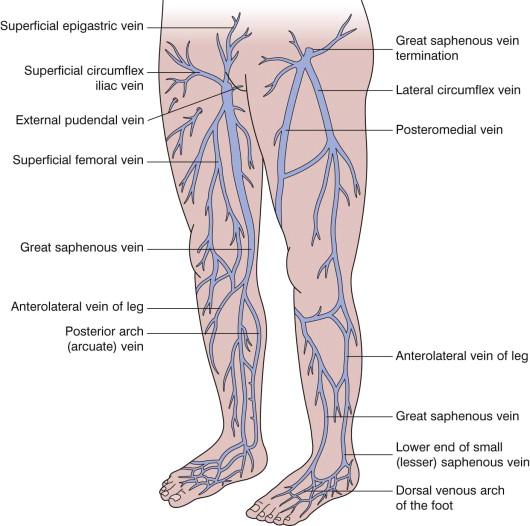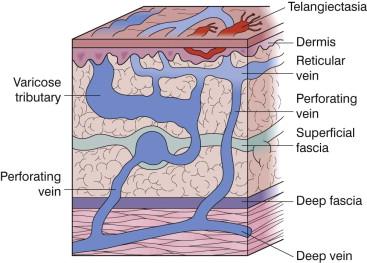Physical Address
304 North Cardinal St.
Dorchester Center, MA 02124
The aim of sclerotherapy is the transformation of a treated vein into a fibrous cord.
Liquid sclerotherapy is the method of choice for telangiectasia and reticular veins.
Foam is more effective than liquid sclerotherapy in saphenous veins, tributaries and venous malformations.
Sclerotherapy involves the injection of a sclerosant for targeted elimination of intracutaneous, subcutaneous, and/or transfascial varicose veins (perforating veins), as well as the sclerosing of subfascial varicose vessels in venous malformations. The various sclerosants markedly damage the vascular endothelium and may possibly damage the entire vascular wall. After successful sclerotherapy, the vein is permanently transformed into a fibrous cord; a process known as sclerosis. The purpose of sclerotherapy is not merely to achieve thrombosis of the vessel, which may be amenable to recanalization, but definitive transformation into a fibrous cord. This cord cannot recanalize and the functional result is equivalent to the surgical removal of a varicose vein.
The objectives of sclerotherapy are:
Treatment of varicosities and prevention of possible complications of varicosities
Reduction or elimination of existing symptoms
Improvement of pathologically altered hemodynamics
Achievement of a good result that satisfies aesthetic and functional criteria
While, in principle, all types of varicose veins are amenable to sclerotherapy, those that are particularly amenable to treatment are:
Saphenous veins (great, GSV) and small saphenous veins (SSV) ( Fig. 36.1 )

Accessory saphenous veins and tributaries
Varicose veins associated with perforator incompetence
Reticular varicose veins ( Fig. 36.2 )

Spider veins
Residual and recurrent varicose veins after interventions to eliminate varicosities
Genital and perigenital varicose veins
Veins causing leg ulcers
Venous malformations.
Sclerotherapy is considered to be the method of choice for the treatment of small-calibre varicose veins (reticular varicose veins, spider veins). For the obliteration of tributary varicose veins and incompetent perforating veins, sclerotherapy competes with percutaneous phlebectomy and with ligation of perforating veins or endoscopic dissection of perforating veins. In the treatment of saphenous varicose veins, foam sclerotherapy is a treatment option comparable with surgery or thermal ablation.
Absolute contraindications according to the European guideline for sclerotherapy are:
Known allergy to the sclerosant
Acute deep vein thrombosis (DVT) or pulmonary embolism (PE)
Local infection in the area of sclerotherapy or severe generalized infection
Permanent immobility of the patient with confinement to bed.
Additional absolute contraindication for foam sclerotherapy:
Known symptomatic right-to-left shunt, e.g., patent foramen ovale.
Relative contraindications which need an individual risk–benefit assessment are:
Pregnancy
Breastfeeding (interrupts breastfeeding for 2–3 days)
Severe peripheral arterial occlusive disease
Poor general health
Strong allergic diathesis
High thromboembolic risk
Acute superficial venous thrombosis.
Additional relative contraindication for foam sclerotherapy:
Visual disturbances or neurological disturbances following previous foam sclerotherapy.
In addition, it is important to adhere to the current prescribing information for the sclerosants used.
Successful sclerotherapy requires thorough planning. Sclerotherapy is generally performed in sequential order of leakage points, proceeding from the larger to the smaller varicose veins. Therefore, a proper diagnostic evaluation must be performed prior to treatment. Diagnostic evaluation before treatment of varicose veins or venous malformations includes history taking, clinical examination, and duplex ultrasound investigation. In spider and reticular veins Doppler investigation may be sufficient. Additionally, functional examinations (e.g., photoplethysmography, phlebodynamometry, venous occlusion plethysmography) may be considered. Functional examinations make it possible to predict the improvement in venous function that may be obtained by removing varicosities. Diagnostic imaging is especially suitable for identifying incompetent junctions within the deep venous system and for locating pathological reflux, as well as for clarifying post-thrombotic changes and for selecting the most appropriate treatment option. For the initial standardized documentation, the CEAP classification including clinical, etiologic, anatomic, and pathophysiologic issues should be used.
Become a Clinical Tree membership for Full access and enjoy Unlimited articles
If you are a member. Log in here